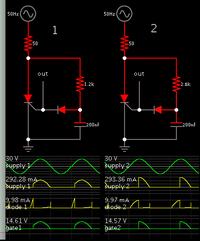bmandl
Full Member level 4
Hello.
I am designing light dimmer with 3 levels of brightness. I am doing this strictly in educational purpose, so I constructed digital circuit with flip flops and nand gates, which outputs digital signal on each press of a button to a 4 different outputs (one for each press). Now, I want to separate this circuit with optocouplers from triggering circuit with triac. 3 levels of brightness will be implemented with string resistor ladder and capacitor.
I need your help to calculate values of resistors and capacitor. At first stage, I want about 120° firing angle, second stage about 60°, third stage about 0° and fourth stage 180°. I can't find useful article on internet on how to calculate values of C and R. There are millions of made circuits with values written, but nowhere to find, how to calculate values for desired firing angle. Also, I don't fully understand how firing delay works with capacitor. Is there any study case, where everything is explained?![IMG_0636[1].jpg IMG_0636[1].jpg](https://www.edaboard.com/data/attachments/65/65772-cc15fe8d3b63d85f6a480fa6fe8ae94b.jpg)
I am designing light dimmer with 3 levels of brightness. I am doing this strictly in educational purpose, so I constructed digital circuit with flip flops and nand gates, which outputs digital signal on each press of a button to a 4 different outputs (one for each press). Now, I want to separate this circuit with optocouplers from triggering circuit with triac. 3 levels of brightness will be implemented with string resistor ladder and capacitor.
I need your help to calculate values of resistors and capacitor. At first stage, I want about 120° firing angle, second stage about 60°, third stage about 0° and fourth stage 180°. I can't find useful article on internet on how to calculate values of C and R. There are millions of made circuits with values written, but nowhere to find, how to calculate values for desired firing angle. Also, I don't fully understand how firing delay works with capacitor. Is there any study case, where everything is explained?
![IMG_0636[1].jpg IMG_0636[1].jpg](https://www.edaboard.com/data/attachments/65/65772-cc15fe8d3b63d85f6a480fa6fe8ae94b.jpg)
